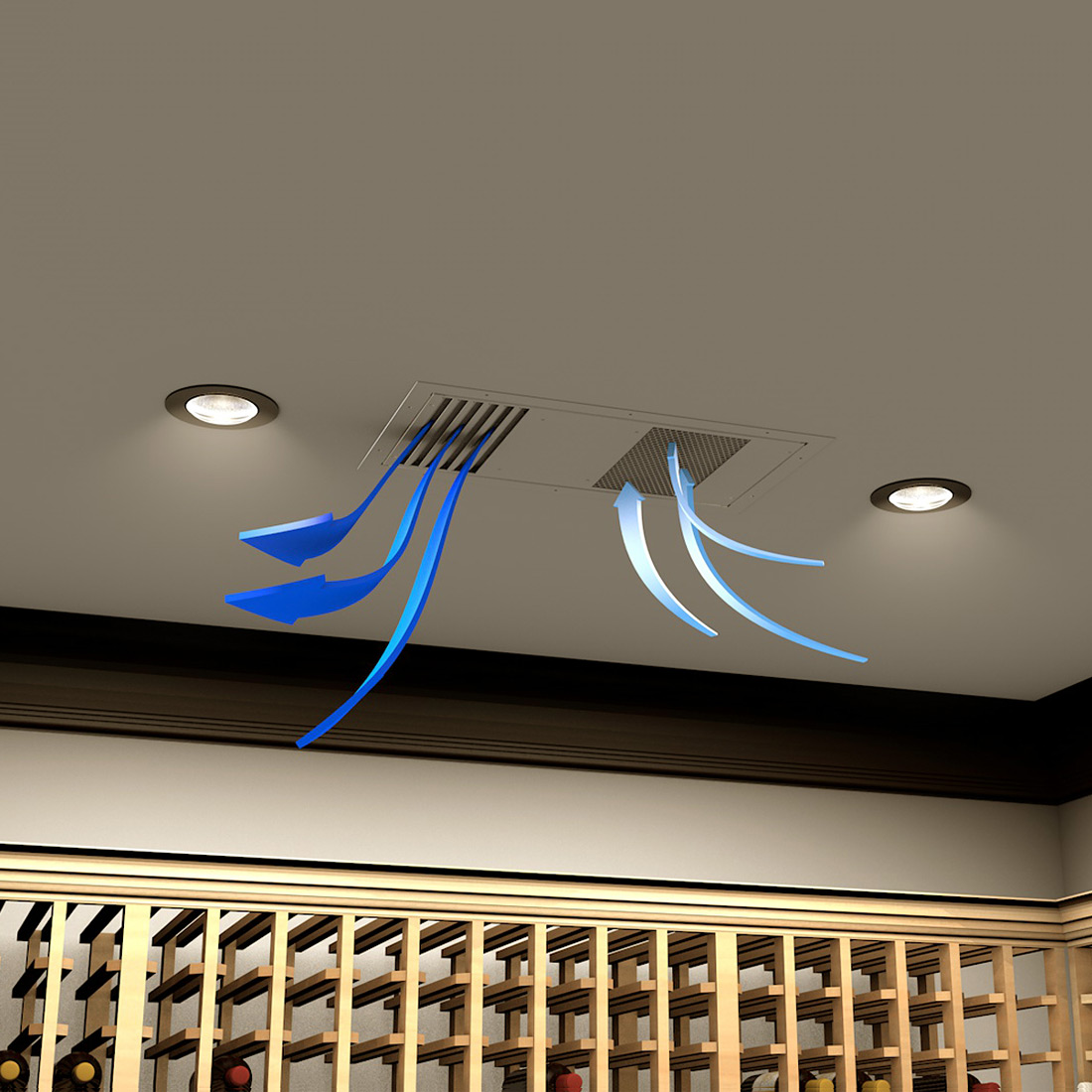Want a super-efficient, space-saving way to keep your home comfortable? Ceiling-mounted mini split ACs might be the perfect solution. This guide covers everything you need to know, from how they work to choosing the right model for your needs. Whether you’re renovating, building, or simply upgrading your HVAC system, read on to unlock the potential of ceiling-mounted mini splits.
Ceiling Mount Mini Splits: Space-Saving Climate Control
Looking for efficient cooling and heating without sacrificing valuable wall space? Ceiling mount mini splits, often called ceiling cassettes, offer a discreet and effective solution. They integrate seamlessly into your ceiling, freeing up walls for furniture, décor, or anything else you desire. But are they the right fit for your home? Let’s explore the specifics.
Understanding Ceiling Cassette Technology
Ceiling mount mini splits operate similarly to other mini-split systems. They consist of two main components: an outdoor condenser and an indoor air handler. Refrigerant lines connect these units, circulating refrigerant to absorb heat from inside your home and release it outside. Think of it as a continuous loop, efficiently managing your indoor temperature.
Advantages of Ceiling-Mounted Mini Splits
Why choose a ceiling mount mini split? Several key benefits may make them an attractive option:
- Space Optimization: Reclaim valuable wall space, making them ideal for smaller rooms or areas where wall space is limited.
- Discreet Design: Ceiling cassettes blend seamlessly into the ceiling, maintaining a clean, minimalist aesthetic.
- Zoned Comfort: Create personalized climate zones in different areas of your home, maximizing comfort and energy efficiency.
- Energy Efficiency: These units are designed for efficient operation, potentially lowering your utility bills.
Exploring Ceiling Mount Mini Split Types
When selecting a ceiling mount mini split, it’s essential to understand the different types available:
- Single-Zone Systems: One indoor unit connects to one outdoor unit, perfect for cooling or heating a single room.
- Multi-Zone Systems: Multiple indoor units (including a mix of ceiling cassettes, wall-mounted units, etc.) connect to a single, more powerful outdoor unit. This configuration is ideal for controlling the climate across multiple rooms or an entire floor.
Determining the Right Size: BTUs and SEER
Choosing the correct size unit is crucial for optimal performance. The BTU (British Thermal Unit) rating indicates a unit’s cooling power. Factors like room size, insulation, and window count influence the required BTU rating. The SEER (Seasonal Energy Efficiency Ratio) measures energy efficiency; a higher SEER means lower energy consumption.
Installation and Maintenance Considerations
Professional installation is generally recommended for ceiling mount mini splits due to the complexity of refrigerant lines and electrical connections. Regular maintenance, including filter cleaning and professional checkups, is essential for optimal performance and longevity. Elevate your home’s aesthetic with the timeless elegance of craftsman crown molding, adding a touch of sophistication and architectural detail. Complete the transformation with the warm, inviting charm of craftsman style interior doors, perfectly capturing the spirit of Arts & Crafts design.
Evaluating the Investment: Cost Factors
Ceiling mount mini splits might have a higher upfront cost than wall-mounted units due to installation complexity. However, the potential long-term energy savings and added comfort may offset the initial investment.
Selecting the Ideal Ceiling Mount Mini Split
When choosing a unit, consider your specific needs. How many rooms do you need to cool? What’s your budget? Research different models, comparing BTU and SEER ratings, noise levels, and brand reliability.
Comparing Ceiling Mount Mini Splits to Other Types
| Feature | Ceiling Mount | Wall Mount | Floor Mount |
|---|---|---|---|
| Space Saving | Excellent | Good | Fair |
| Aesthetics | Excellent | Good | Fair |
| Air Distribution | Excellent | Good | Fair |
| Installation | More Complex | Less Complex | Less Complex |
| Cost | Higher | Lower | Lower |
This table offers a general comparison; individual models within each category can vary. Further research is always recommended.
Can a Mini Split Be Mounted on a Ceiling? Absolutely!
Yes, mini splits can be mounted on the ceiling using specialized units called ceiling cassettes. These offer a discreet, space-saving alternative to wall-mounted units, seamlessly integrating into your ceiling. They are an excellent choice for those seeking a minimalist aesthetic or maximizing floor space.
How Ceiling Cassettes Work
Ceiling cassettes house the evaporator coil, blower fan, and condensate drain pan within a compact unit installed in the ceiling. A decorative grille blends with your ceiling, providing discreet air distribution. Refrigerant lines connect the indoor unit to the outdoor compressor, forming a closed loop that efficiently transfers heat.
Sizing Your Ceiling Cassette: BTU Ratings
Choosing the correct BTU rating is essential for effective cooling and heating. A qualified HVAC technician can help determine the appropriate BTU rating based on your room size, insulation, and other factors.
Professional Installation: A Necessity
Professional installation is crucial for ceiling cassettes due to the complexities of refrigerant handling and electrical connections. A professional installer will also ensure proper mounting and safe electrical connections.
Weighing the Pros and Cons of Ceiling Cassettes
Pros:
- Space-saving design
- Discreet aesthetics
- Even air distribution
- Quiet operation
Cons:
- Professional installation required
- Higher upfront cost
Choosing the Right Ceiling Cassette
Consider these factors when selecting a ceiling cassette:
- BTU rating
- SEER rating for energy efficiency
- Noise levels
- Brand reputation and warranty
Ceiling Cassettes vs. Other Mini Splits
Ceiling cassettes offer distinct advantages over wall-mounted and floor-mounted units, particularly in space optimization, air distribution, and discreet design. While potentially more expensive upfront, their long-term benefits often make them a worthwhile investment.
Are Ceiling Mini Splits Worth It? A Balanced Perspective
Ceiling mini splits, or ceiling cassettes, offer a compelling combination of space-saving design, even air distribution, and quiet operation. However, understanding the pros and cons is essential to decide if they’re the right choice for your needs.
The Appeal of Discreet Climate Control
Ceiling cassettes provide a hidden cooling and heating solution, preserving valuable wall space and maintaining a clean aesthetic. But are they suitable for every situation? Let’s explore the advantages and disadvantages.
Evaluating the Pros and Cons
Pros:
- Space maximization
- Balanced air distribution, eliminating hot and cold spots
- Discreet, hidden design
- Year-round comfort with heating and cooling capabilities
Cons:
- Higher upfront investment compared to wall-mounted units
- Requires professional installation and sufficient ceiling/attic space
- Maintenance can be slightly more complex
Long-Term Value: Cost vs. Benefit
While the initial cost may be higher, ceiling cassettes offer potential long-term energy savings. Their discreet design and enhanced comfort can also potentially increase your home’s value.
Navigating the Installation Process
Professional installation is essential. Ensure clear access to the ceiling or attic for refrigerant lines, electrical wiring, and potential ductwork. Discuss the process with your installer to avoid surprises.
Making an Informed Choice: Selection Criteria
Consider these key factors:
- BTU rating for appropriate cooling capacity
- SEER rating for energy efficiency
- Noise levels for quiet operation
- Smart home integration features for enhanced control and energy savings
Ceiling Cassette vs. Wall-Mounted: A Comparison
| Feature | Ceiling Cassette | Wall-Mounted |
|---|---|---|
| Space Saving | Excellent | Good |
| Air Distribution | Excellent, even flow | Good, directional |
| Aesthetics | Discreet, hidden | More visible |
| Installation Cost | Higher | Lower |
| Maintenance | More Complex | Less Complex |
The Verdict: A Personalized Decision
Whether ceiling mini splits are “worth it” depends on your priorities. If space optimization, discreet design, and balanced airflow are paramount, then they may be an excellent long-term investment. Consult with a qualified HVAC professional to assess your specific needs and budget.
How Do Ceiling Mini Splits Drain? Condensate Removal Explained
Ceiling mini splits handle condensate drainage differently than other AC units. Instead of relying solely on gravity, they utilize a condensate pump to actively remove moisture collected during operation.
The Role of the Condensate Pump
The condensate pump pushes the collected water upward through a drain line, which must be properly sized and sloped downward to facilitate efficient drainage.
Drain Line Considerations
The drain line plays a crucial role. Proper sizing and sloping (even a slight downward angle) help the pump function effectively, preventing clogs and backups.
Maintaining Your Drainage System
Regular maintenance, including cleaning the pump and drain line, prevents the buildup of dust, debris, and algae, ensuring efficient operation.
The Overflow Safety Switch: Your Backup Plan
An overflow safety switch monitors water levels inside the unit. If water accumulates due to a pump failure or clog, the switch shuts down the system, preventing potential water damage.
Troubleshooting Common Drainage Issues
| Problem | Possible Solutions |
|---|---|
| Leaking | Check the drain line for clogs, kinks, or damage. Inspect the condensate pump. |
| No drainage | Ensure the pump receives power and functions correctly. Check for line blockages. |
| Overflowing | Check the overflow safety switch and drain line for clogs. Inspect the pump. |
| Loud pump noises | The pump may be struggling and require replacement. |
Drain Line Length and Additional Pumps
Condensate pumps have a limited vertical lift capacity. For long drain lines or significant vertical lifts, a second pump might be necessary.
Ongoing Research and Future Innovations
Research continually strives to improve mini split efficiency. Some experts suggest future models may incorporate advanced drainage systems with sensors and self-cleaning mechanisms.
By understanding the mechanics of condensate removal in ceiling mini splits, you can effectively maintain your system and troubleshoot potential issues, ensuring efficient and reliable operation.
- How to Get Gum Out of Carpet: Tried-and-True Methods That Really Work - April 23, 2025
- How to Get Urine Smell Out of Your Couch: A Complete Guide - April 23, 2025
- How to Get Pee Smell Out of Your Couch: A Complete Guide - April 23, 2025










